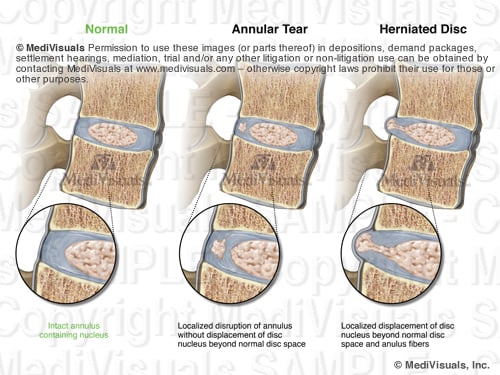By: Robert Shepherd MS, Certified Medical Illustrator, Vice President and Director of Eastern Region Operations, MediVisuals Incorporated
This blog is a follow-up referencing language and labels used by health professionals to describe various types of intervertebral disc pathology as defined by a 1995 joint undertaking by representatives from the North American Spine Society, American Society of Spine Radiology and American Society of Neuroradiology. As a result of their efforts, a more uniform and widely accepted use of nomenclature to define intervertebral disc pathology was developed and published in "Nomenclature and Classification of Lumbar Disc Pathology".
A previous blog dealt with "Symmetrical" and "Asymmetrical" disc "bulge" and "Broad-based" v. "Focal" Herniations. The first disc pathology term discussed in this blog is "Annular Tear". This is essentially synonymous with "Annular Fissure," with perhaps "Fissure" being preferable over "Tear" because "Tear" may imply that the pathology was the result of some sort of traumatic event, and this specific pathology can occur without necessarily being the result of trauma. Annular Tears/Fissures, as seen in the below figure, can occur without fitting the definition of a "Herniation" (disc material extruding beyond its normal boundaries). As seen in the below illustrations, the fibers of the annulus can be torn with nucleus protruding into the annulus but without the annulus or nucleus extending beyond the bordering vertebral bodies. By contrast, when "Anular Tears/Fissures" result in disc material extending beyond its normal boundaries, the disc pathology is typically referred to simply as a "Herniation" without a reference to the presence of an Annular Tear/Fissure".

Another blog will be coming soon regarding disc "Protrusions" and "Extrusions".










